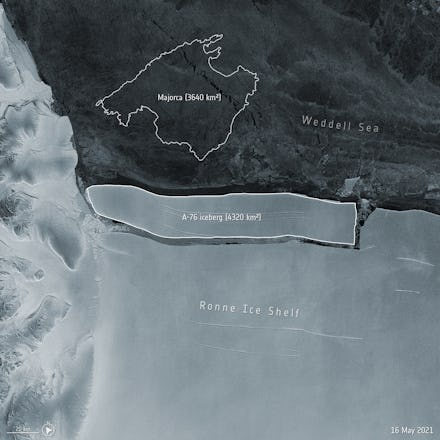Let's all nervously greet A-76, a new iceberg 5 times the size of New York City

Please join me in welcoming to the world A-76, a bouncing baby iceberg born this week in Antarctica to loving parents Ronne Ice Shelf and Weddell Sea. Despite being just days old, A-76 is believed to be the largest iceberg on Earth, according to the European Space Agency, which announced the discovery of this gigantic baby 'berg on Wednesday.
According to the ESA, A-76 measures in at a whopping 170 kilometers long and 25 kilometers wide, for a grand total of around 4,320 square kilometers. That puts it roughly a quarter again larger than the entire state of Rhode Island, which comes in at a paltry 3,144 kilometers square. (Or, as the ESA notes, it's "slightly larger than the Spanish island of Majorca.")
So, yeah, this is one big chunk o' ice.
"The enormity of the 'berg makes it the largest in the world, snatching first place from the A-23A iceberg (approximately 3880 square kilometers in size) which is also located in the Weddell Sea," the ESA explained. "In comparison, the A-74 iceberg that broke off the Brunt Ice Shelf in February earlier this year, was only 1270 square kilometers."
While the birth of a new baby 'berg is, in and of itself, not exactly monumental news — icebergs cleave off their paternal ice sheets all the time — the sheer size of A-76 (so named for the Antarctic quadrant in which it was born) makes it noteworthy and, frankly, hard to wrap one's brain around. This thing is simply mind-meltingly huge. A chunk of ice around five times bigger than all of New York City is just ...out there, floating around, without a care in the world. Must be nice, honestly.
While it's easy to name man-made climate change as a potential factor in A-76's split from the ice shelf from which it came, it's important to remember that icebergs pack their bags and leave home for any number of reasons, many of which have nothing to do with humanity's disastrous stewardship of our home planet. As Snow and Ice Physics Professor Chris Borstad explained to the BBC when a similarly (if only slightly smaller) brobdingnagian chunk of ice broke free of the Larsen C ice shelf a few years ago: "At this stage we really don’t know whether there is some larger-scale process that might be weakening this zone, like ocean melting at the base of the shelf, or whether the current rift was just a random or episodic event that was bound to happen at some point."
Still, whether birthed by man-made climate change, the unfathomable machinations of planet Earth, or some combination of the two, what matters is A-76 is here now. Welcome to the world you big, beautiful 'berg.